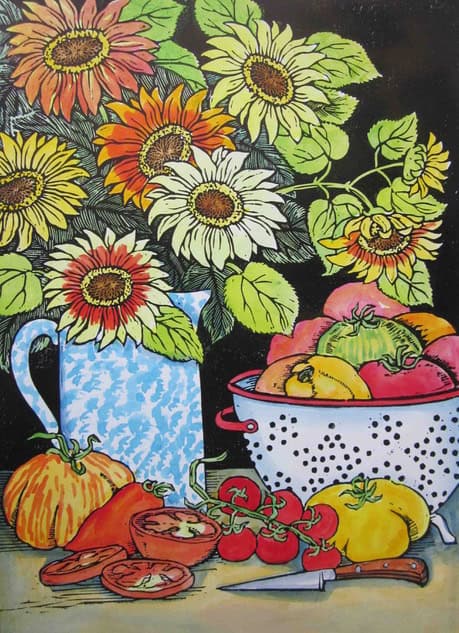For the new seed saver, start by planting varieties that are easy to grow and simple to collect. Select annuals that are open-pollinated and primarily self-pollinating which allows the seed to stay true to form. A good place to start might be the following list of edible plants, each takes up the same space in your vegetable garden when being grown for seed as they would when grown for fresh eating.

Beans: For most home gardeners, a single plant will yield enough for another year’s garden, and saving seeds in the fall is as simple as sowing in the spring. Beans produce blossoms that will self-pollinate, followed by a seedpod. Harvest to eat fresh, or leave a few on the vine to develop into a seedpod that will produce four to eight seeds each. When left to dry on the vine, they will turn brown and slightly wither. Harvest when fully dry, crack open to separate the beans or leave in the pod until ready to plant the following season. Seeds will be viable for three to four years.
Pepper: Primarily grown for their edible fruit, first the blossom appears followed by the pepper. Sweet peppers tend towards self-pollination, while hot peppers are more likely to cross-pollinate with other peppers. For optimal seed saving, isolate the plants with a lightweight covering when flowering. Seeds are ready to harvest with the fruit is fully mature. Harvest off the plant, and split open the fruit; scrape the seeds from the core and rinse off any pulp. Spread seeds on a single layer of paper towels to dry. Pepper seeds can be expected to remain viable for two to four years.
Calendula: The sole purpose of all annual flowers is to set seed, which is why keep the spent flower heads trimmed is key to longevity in the garden. At the end of the season, allow blossoms to form into seed heads on the plant. Keep a watchful eye that you collect them before they scatter to the ground. Harvest when full dry, when the seed pods turn from green to brown. Harvest tops with scissors and bring inside to fully dry. Break apart with fingers to separate the seeds, which look like tiny snails, and may require cleaning the chaff from the seed. Seeds will remain viable for three to four years.
Peas: Regardless if peas are classified into different eating types: snap, edible pods or snow peas, the seeds inside the pods can be saved for planting again. An excellent choice for the new seed saver, this beautiful plant produce self-pollinating flowers which makes them an ideal candidate for successful seed saving. From the spring of fall planting, set aside a few plants and allow the pods to grow past the green stage, to a withered stage with peas inside slightly bulging. Ready to harvest when they are still leathery, pick and arrange on a screen indoors to continue drying until the seeds inside the pods are hard and seeds are fully formed. Seeds will remain viable for three to four years.
Tomatoes: Most gardeners are passionate about their favorite heirloom tomatoes, yet tomatoes may be one of the trickier plants to collect seeds. They require isolation for accurate pollination, and follow specific techniques for successful germination. Seeds are ready to harvest when fruits change from green to the ripe color of their variety, typically red or yellow, and when slightly soft to touch. Cut the tomato in half, and extract the seeds by gently squeezing them along with the pulp and juice into a container. Cover with cheesecloth, and keep at 70* which will trigger fermentation. Within a week, a gelatinous covering will form, gently stir, and the viable seeds will settle to the bottom, while the seeds that float to the top can be removed and discarded. Strain and wash seeds , then dry on screens. Tomato seeds will remain viable four to six years.
Lettuce: Most gardeners harvest their lettuce long before it goes to seed, and rarely allow the tall central seed stalk to form into a seed head. When one of these overgrown lettuce plants is allowed to go to seed, however, it can produce thousands of seeds, enough to last for a few seasons to come. After the main flower stalk appears, and smaller side shoots grow, watch as small yellow flowers appear. Over time, these will eventually turn to a soft gray fluff, indicating that seed is forming. Check the plants often and when you can see tiny brown seeds have formed, harvest the whole stalk and secure the seed head inside a paper bag. Hang upside down, to separate the seed from the chaff. Lettuce will remain viable for five to seven years.
Seed Packets & Seed Storage
When seeds are completely dry, place and seal in paper envelopes, label with harvest date, varietal name, and any information that will help you keep track of the origin. Store in glass jars, ideally with a desiccant pack, in a cool, dry location, away from direct sunlight. For long-term storage, seeds can be placed in a deep freezer, not the same one used for daily use, which will cause fluctuating temperatures and moisture, but in a chest type freezer. Moisture will cause seed to lose it’s viability, so once seeds are removed from storage, take only what you will plant and return the rest back to maintain it’s integrity.


